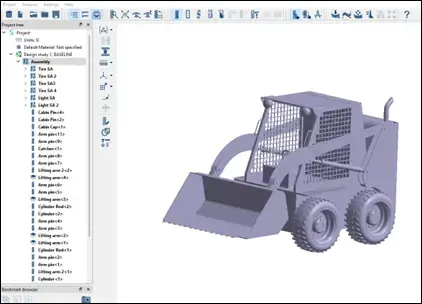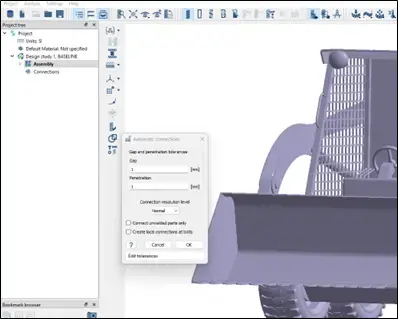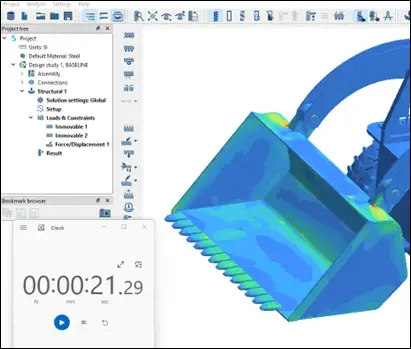Altair SimSolid for Large Assemblies
Altair SimSolid is ideal for industries that typically use large assemblies like industrial or heavy machinery. See why so many use it for early simulation.
One of the fastest growing industries using Altair SimSolid is the field of heavy machinery design. SimSolid offers unique benefits to this industry, or any industry dealing with very large assemblies, that enhance efficiency, reliability, and innovation in engineering processes.
If you aren’t familiar with Altair SimSolid, it’s an engineering simulation tool and uses a unique approach to structural analysis, bypassing traditional finite element analysis (FEA) methods to provide faster results while maintaining accuracy.
In this blog, we will delve into the advantages of using Altair SimSolid for designing heavy machinery, highlighting how it streamlines workflows, reduces development times, and facilitates more design options.
Rapid Analysis Times
One of the standout features of Altair SimSolid is its ability to deliver rapid analysis times. Unlike traditional FEA, which requires detailed meshing, that can be time-consuming, SimSolid performs structural analyses on fully featured, native CAD assemblies directly.
This eliminates the need for the time-consuming process of simplifying models and creating meshes, which significantly speeds up the analysis phase. Engineers can now receive feedback on their designs in minutes or seconds, rather than hours or days. This acceleration in analysis times allows for more iterative design cycles, enabling engineers to explore a wider range of design options and make faster, data-driven decisions.
With heavy or industrial machinery, often the assemblies are hundreds or thousands of parts. With traditional FEA tools, the simplification, meshing, and computing time needed to run a simple design validation makes it not feasible in many situations.
For example, in the skid steer assembly shown in Fig 1, more than 200 native SOLIDWORKS parts are included. SimSolid was able to open this assembly without conversion, in seconds.

Fig 1: Skid Steer assembly in SimSolid interface
In traditional FEA workflows, engineers often spend a significant amount of time simplifying models to make them suitable for analysis. This can include removing small features, fillets, and other complexities that, while crucial to the manufacturing process, can be irrelevant to and complicate the analysis.
Altair SimSolid, however, can handle complex geometries without simplification, analyzing the model as it is. This means that the analysis is more representative of the real-world scenario, improving the reliability of the results. The ability to work with complex, assembly-level models directly reduces the risk of errors introduced through model simplification and ensures that the design integrity is maintained throughout the analysis process.
SimSolid has the ability to manage connections automatically according to user's settings, as seen in Fig 2 below, which allows the users to move right into setting up their analysis. What would typically take hours of model preparation can be shortened to seconds using SimSolid.

Fig 2: Automatic Connections settings
Enhanced Accuracy and Reliability
Altair SimSolid's approach to structural analysis not only speeds up the process but also enhances the accuracy and reliability of the results. By analyzing fully featured CAD models, SimSolid captures the true physical behavior of the design (rather than a simplified model), including the interactions between different components in an assembly. This results in a more accurate representation of stresses, deformations, and other critical parameters.
For heavy machinery design, where safety and performance are paramount, the increased accuracy and reliability of SimSolid's analyses can lead to better-informed design decisions and higher-quality machinery. Users can choose between various options on the type of analysis to run including structural linear and nonlinear analysis, buckling, thermal (both steady-state and transient), frequency and dynamics, fatigue and more.
Integration with Design Processes
Because SimSolid is very beneficial during the design phase, another significant benefit of it is its seamless integration into existing design processes. Users can directly import native CAD formats, as previously discussed, or as a SOLIDWORKS add-in, users can import a study directly from within the interface.
The software is compatible with a wide range of CAD platforms, allowing engineers to easily import their models for analysis. Typically, SimSolid analysis can be run without closing the CAD interface.
This integration facilitates a more cohesive workflow, where design and analysis go hand in hand. Engineers can quickly identify potential issues and make necessary adjustments to their designs within their preferred CAD environment, enhancing efficiency and reducing the likelihood of costly reworks or delays in the development timeline.
Cost and Time Savings
The cumulative effect of the advantages offered by Altair SimSolid is significant cost and time savings. These savings are not just limited to the design phase but extend throughout the product lifecycle, as better-informed design decisions can lead to machinery that is more efficient, durable, and easier to maintain.
For example, with the skid steer model, running a basic stress test on the shovel of the design:
Applying constraints – roughly 60 seconds
Applying Load - <10 seconds
Running Analysis – 21.29 seconds (Fig 3 below)

Fig 3: Stopwatch time for structural linear analysis run time.
Altair SimSolid is picking up steam, no pun intended, in heavy machinery design, offering a suite of benefits that address the challenges of traditional structural analysis methods. Its ability to provide rapid, accurate, and reliable analyses without the need for model simplification or meshing is a significant benefit. By integrating seamlessly with existing CAD workflows, SimSolid enhances the overall efficiency of design teams, allowing them to deliver higher-quality machinery to the market faster and at a lower cost.
To learn more about Altair SimSolid or speak with us directly, let us know at [email protected].
